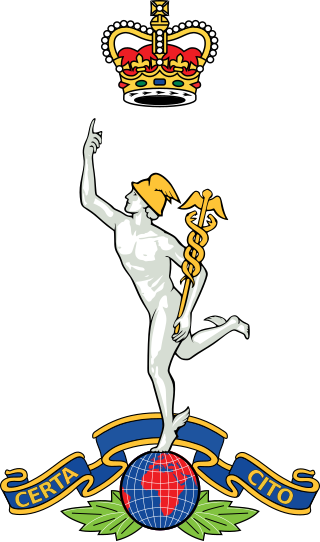
The Royal Corps of Signals is one of the combat support arms of the British Army. Signals units are among the first into action, providing the battlefield communications and information systems essential to all operations. Royal Signals units provide the full telecommunications infrastructure for the Army wherever they operate in the world. The Corps has its own engineers, logistics experts and systems operators to run radio and area networks in the field. It is responsible for installing, maintaining and operating all types of telecommunications equipment and information systems, providing command support to commanders and their headquarters, and conducting electronic warfare against enemy communications.

Corsham is a historic market town and civil parish in west Wiltshire, England. It is at the south-western edge of the Cotswolds, just off the A4 national route, 28 miles (45 km) southwest of Swindon, 20 miles (32 km) east of Bristol, 8 miles (13 km) northeast of Bath and 4 miles (6 km) southwest of Chippenham.

Box is a large village and civil parish within the Cotswolds Area of Outstanding Natural Beauty in Wiltshire, England, about 3 miles (5 km) west of Corsham and 5 miles (8 km) northeast of Bath. Box also falls in the easternmost part of the Avon Green Belt. Besides the village of Box, the parish includes the villages of Ashley and Box Hill; Hazelbury manor; and the hamlets of Alcombe, Blue Vein, Chapel Plaister, Ditteridge, Henley, Kingsdown, Middlehill, and Wadswick. To the east the parish includes much of Rudloe, formerly a hamlet but now a housing estate, and the defence establishments and related businesses on the site of RAF Rudloe Manor.
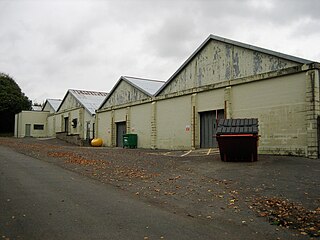
Larkhill is a garrison town in the civil parish of Durrington, Wiltshire, England. It lies about 1+3⁄4 miles (2.8 km) west of the centre of Durrington village and 1+1⁄2 mi (2.4 km) north of the prehistoric monument of Stonehenge. It is about 10 mi (16 km) north of Salisbury.

The United Kingdom's Strategic Command (StratCom), previously known as Joint Forces Command (JFC), manages allocated joint capabilities from the three armed services.
The Corsham Computer Centre (CCC) is an underground British Ministry of Defence (MoD) installation in Corsham, Wiltshire, built in the 1980s. According to the MoD, the centre "processes data in support of the Royal Navy". The centre has been similarly described by Des Browne in 2007, then Secretary of State for Defence, as a "data processing facility in support of Royal Navy operations".
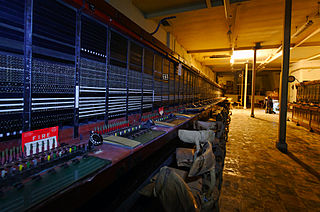
The Central Government War Headquarters (CGWHQ) is a 35-acre (14 ha) complex built 120 feet (37 m) underground as the United Kingdom's emergency government war headquarters – the hub of the country's alternative seat of power outside London during a nuclear war or conflict with the Soviet Union. It is in Corsham, Wiltshire, in a former Bath stone quarry known as Spring Quarry, under the present-day MoD Corsham.

RAF Rudloe Manor, formerly RAF Box, was a Royal Air Force station located north-east of Bath, England, between the settlements of Box and Corsham, in Wiltshire. It was one of several military installations situated in the area and covered three dispersed sites. The sites are now used by Defence Digital.

The Defence Communication Services Agency (DCSA) was an agency of the United Kingdom Ministry of Defence responsible for the procurement and delivery of Communications and Information Services (CIS) to the defence community and related public and private sector bodies. The Agency was formed on 1 April 1998, bringing together a range of CIS organisations across all three services.

Aldershot Garrison, also known as Aldershot Military Town, is a major garrison in South East England, between Aldershot and Farnborough in Hampshire. The garrison was established when the War Department bought a large area of land near the village of Aldershot, with the objective of establishing a permanent training camp for the Army. Over time, this camp grew into a military town and continues to be used by the Army to the present day. It is home to the headquarters of the Army's Regional Command, and it is also the administrative base for the 101st Logistic Brigade. The garrison plays host to around 70 military units and organisations.
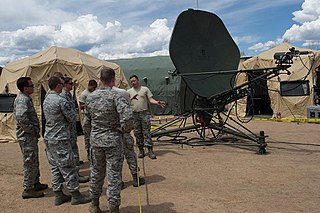
Reacher is a mobile X‐Band Satellite ground terminal (SGT) acquired by the British Ministry Of Defence, it is designed to replace all medium and large legacy SGTs used in the land environment. It is intended to deliver services through Skynet 5 satellites, and to assist in the transition to TCP/IP network protocol services. Reacher was brought into service in 2007.
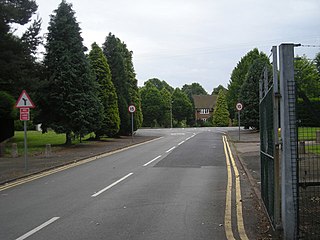
MoD Donnington is a British military base situated to the north of Donnington, Telford, Shropshire.
The National Cyber Security Centre (NCSC) is an organisation of the United Kingdom Government that provides advice and support for the public and private sector in how to avoid computer security threats. Based in London, it became operational in October 2016, and its parent organisation is GCHQ.

The structure of the British Army is being reorganised to the Future Soldier structure. The Army is commanded by the Chief of the General Staff (CGS), with Army Headquarters which is located in Andover, Hampshire. Subordinate to that post, there is a Commander Field Army, and a personnel and UK operations command, Home Command.
The 10th Signal Regiment is a current regiment of the Royal Corps of Signals within the British Army.

The 13th Signal Regiment is a specialist signals unit of the Royal Corps of Signals of the British Army. Originally formed in 1934, the regiment had a long history of service before being disbanded in 1994 following the initial Options for Change reforms. The regiment was be reformed in June 2020 as part of 1st Signal Brigade.
This is the structure of the British Armed Forces, as of October 2021.

The Cyber and Electro Magnetic Activities Effects Group is a combat support formation of the British Army due to form by late 2022. The group will bring together three specialist regiments of the Royal Corps of Signals under Commander Field Army.
The Field Army Troops is the name given to those units falling under direct control of Headquarters, Field Army.
















